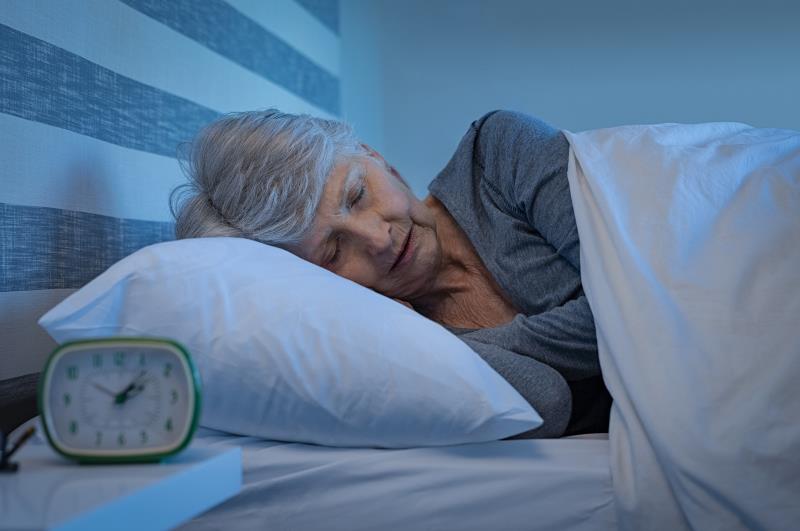
The dual orexin receptor antagonist lemborexant effectively promotes sleep by improving both the onset and maintenance of sleep compared with placebo or zolpidem in older patients with insomnia, the SUNRISE 1* trial has shown.
“Cognitive behaviour therapy for insomnia is a first-line insomnia therapy and has been shown to improve sleep in older patients with insomnia,” the researchers pointed out. “However, pharmacologic treatment may be necessary in cases in which cognitive behaviour therapy for insomnia is not effective or not accessible to the patient.”
As sedative-hypnotic drugs may be associated with adverse effects leading to falls and risk of unintentional injury in older adults, dual orexin receptor antagonists may present as an alternative therapy to existing treatments.
Improvements on objective measures
In the double-blind, parallel-group, phase III study, 1,006 participants aged ≥55 years (median age 63 years, 86.4 percent women) with insomnia disorder in a 5:5:5:4 ratio to receive lemborexant 5 mg or 10 mg, zolpidem 6.25 mg, or placebo for a month at bedtime. [JAMA Netw Open 2019;2:e1918254]
Both doses of lemborexant improved objective sleep onset from baseline to a significantly greater extent than placebo, as measured using polysomnography on the last two nights of treatment (geometric least squares means [GLSM] ratios, 0.77 and 0.72 for lemborexant 5 mg and 10 mg, respectively; p<0.001 vs placebo for both).
Improvements in objective measures (based on polysomnography) of sleep maintenance were also significantly greater with lemborexant vs placebo — as indicated by change in sleep efficiency (LSM treatment difference, 7.1 percent and 8.0 percent for lemborexant 5 mg and 10 mg, respectively; p<0.001 vs placebo for both) and wake-after-sleep-onset (WASO; LSM ratios, -24.0 min and -25.4 min, respectively; p<0.001 for both).
“The decreases in sleep-onset latency with lemborexant therapy were notable, as most participants fell asleep in less than 20 minutes,” said the researchers. “Participants receiving lemborexant therapy also gained more than 60 minutes of sleep per night than they had before treatment.”
Compared with the sedative-hypnotic zolpidem, both doses of lemborexant similarly improved WASO on the second half of the last two nights of treatment to a greater extent (LSM treatment difference, -6.7 min and -8.0 min for lemborexant 5 mg and 10 mg, respectively; p=0.004 and p<0.001 for each comparison vs zolpidem).
“Both doses were effective on the first two and last two nights of treatment, indicating that lemborexant therapy works immediately and over time,” noted the researchers. “This finding is in contrast to zolpidem therapy, which improved sleep onset initially [nights 1 and 2] but became less effective over time, with no difference from placebo on LPS** after the month of treatment.”
Similar findings for subjective measures
Lemborexant improved subjective patient-reported measures of sleep onset indicated by sSOL*** on sleep diaries during the first seven nights (GLSM treatment ratios, 0.82 and 0.75 for lemborexant 5 mg and 10 mg, respectively) and at the end of one month (GLSM ratios, 0.75 and 0.69, respectively), compared with placebo (p<0.001 for all).
For sleep maintenance, significantly greater improvements were also seen with both doses of lemborexant compared with placebo during the first seven nights and at the end of one month, in terms of subjective sleep efficiency (p<0.001 for all) and subjective WASO (p<0.05 for lemborexant 5 mg and p<0.001 for lemborexant 10 mg).
In addition, lemborexant was well tolerated — fall occurred to four participants in the lemborexant 5 mg group and serious adverse events were reported in six participants, but none were considered related to be treatment-related.
“Results of this first head-to-head phase III clinical trial are encouraging and support continued development of lemborexant therapy for the treatment of insomnia disorder,” said the researchers.
Following the results of SUNRISE 1 and 2 trials, the US FDA has recently approved the drug for treating insomnia in adults.